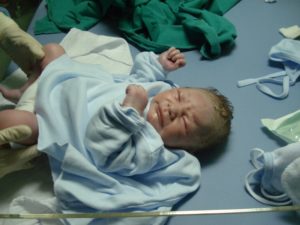Birth Injury Causes
Cerebral palsy is a neurological disorder caused by damage to a baby’s developing brain. This brain damage typically occurs during labor, but can also occur late in pregnancy or even shortly after birth. It’s estimated that 1 in 1,500 live births result in a child developing cerebral palsy, often as a direct result of the child’s oxygen supply (blood flow) being cut off for several minutes during labor.
All to often, the devastating birth injuries which lead to cerebral palsy occur due to simple negligence on behalf of the very doctors, nurses, and other medical professionals you’ve entrusted. Medical malpractice is the most-common cause of preventable birth injuries, which can occur in a variety of ways.

Birth Injuries & Cerebral Palsy
Birth Injuries Caused by Pitocin
One source of brain trauma that’s associated with the occurrence of cerebral palsy is an adverse reaction to medication such as Pitocin, an artificial oxytocin analogue which is provided to mothers who may be having a hard time experiencing reliable contraction as well as pushing. While effective, Pitocin may cause a serious adverse reaction or produce unusually strong uterine contractions, which can lead to the baby’s head being contracted by these muscles, ultimately leading to brain trauma.
Forceps & Vacuum Extraction
The use of forceps, clamps, and vacuum pumps can place an extraordinary amount of pressure on a baby’s still pliable head, making it likely for brain tissue trauma to occur. Any kind of brain injury that a baby sustains while still very young has a deleterious effect on cells found in the brain that are responsible for muscle movement.
Hemorrhages and Bleeding in the Brain
Brain bleeding and hemorrhages can also contribute to the development of cerebral palsy. This form of bleeding can either happen inside brain tissue or intercranially, and it can be caused by a number of things such as fetal distress, macrosomia, prolonged labor, blood pressure fluctuations, a breech birth, a reduced oxygen supply, and blood disorders that doctors know to look for and identify. Any form of bleeding into the brain (or the surrounding tissue) will cause cells to malfunction and die within minutes, paving the way for cerebral palsy to develop.
Placental Abruption
Placental abruption is a condition that involves the separation of the placenta from the uterus before the birth of the baby. This usually leads to severe bleeding, which can induce shock and subsequently, brain damage or even fetal death. This condition occurs in 1 of every 600 live births in the country, and physicians are required to examine a pregnant woman for risk factors associated with it.
Placental abruption is said to be common in older mothers as well as those suffering from high blood pressure. In fact, doctors are advised to perform a C-section if there are signs of fetal distress, in order to reduce the likelihood of a serious birth injury.
There are Many Types of Birth Injuries Which Can Lead to Cerebral Palsy
The scenarios discussed only account for a fraction of the types of birth injuries which may lead to the development of cerebral palsy.
Newborn babies are extremely vulnerable to injury, and doctors know this all too well. This is why they are paid well for what they do, and why victims of medical malpractice often seek compensation should their doctors fail in their official duties and cause serious injury to the mother and/or child.
At the end of the day, doctors are required to do their due diligence during a mother’s pregnancy, labor, and delivery to anticipate and mitigate all these risk factors to ensure the birth of a healthy baby. Not all birth injuries can be traced back to negligence, but often the only way to learn the truth about what actually happened is to have an attorney evaluate the strength of your case. Cerebral Palsy birth injury lawyers usually do this for no charge, so if you feel as though your family may have a potential claim, discuss your options with a trusted CP attorney.
